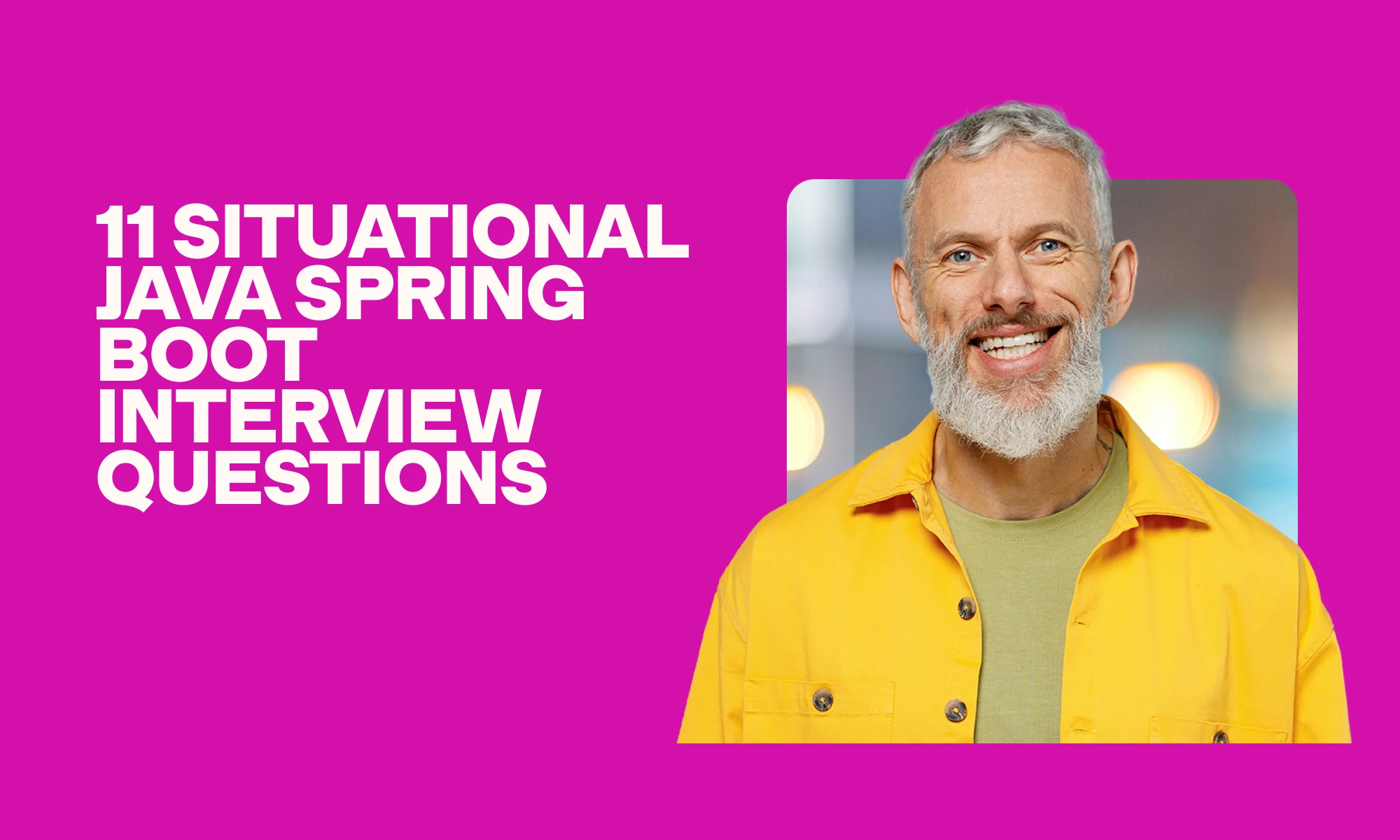53 Java Spring Boot interview questions for assessing developers’ skill
Find Java Spring Boot experts easily with TestGorilla
Finding a skilled developer with Java Spring Boot expertise can be hard – and before you hire them, you need to ensure they possess all the other skills required for the role.
A handy method to evaluate your applicants’ Java Spring Boot skills, including soft skills, is to use skills tests – and conduct interviews with the right Java Spring Boot interview questions.
At TestGorilla, we’re aware that coming up with the right interview questions for developers can be difficult, especially if you have no coding skills yourself.
So, if you need some fresh ideas to put your list together, this article is for you: In it, you’ll find a comprehensive list of 53 Java Spring Boot interview questions – along with sample answers to some of them to help you evaluate candidates’ skills and knowledge.
Let’s get to the list.
Table of contents
- 21 Java Spring Boot interview questions to ask junior developers
- 5 Java Spring Boot interview questions and answers to assess junior developers
- 21 Java Spring Boot interview questions to ask senior developers
- 5 Java Spring Boot interview questions and answers to assess senior developers
- 11 situational Java Spring Boot interview questions to ask applicants
- 5 situational Java Spring Boot interview questions and answers
- For what kind of roles can you use Java Spring Boot interview questions?
- During which stage of the recruitment process should you use these Java Spring Boot interview questions?
- Why use skill testing to assess developers’ skills?
- Hire top developers using skill tests and Java Spring Boot interview questions
21 Java Spring Boot interview questions to ask junior developers
Ask junior developers these 21 Java Spring Boot interview questions to determine if their knowledge matches the requirements of your role.
Explain what Java Spring Boot is.
Name five Java Spring Boot features.
Name four advantages of using Java Spring Boot.
Outline four critical Java Spring Boot components.
Which skills do you need to use Java Spring Boot?
Which soft skills do you think are needed to use Java Spring Boot?
What are you doing to improve your skills?
Explain what makes Java Spring Boot different from Spring.
Explain how Java Spring Boot works.
Explain what the annotation @SpringBootApplication does.
Explain what the @ComponentScan annotation does and how to use it.
Explain how to start a Java Spring Boot application.
Explain what starter dependencies are.
Explain what the Spring initializer is.
Explain what the Java Spring Boot CLI is.
Name one key advantage of using the Java Spring Boot CLI.
Name seven frequently-used Java Spring Boot CLI commands.
What are the various phases of the RAD model?
Explain what the RAD model is.
Explain what DevTools does in Spring Boot.
Explain what spring-boot-starter-parent is.
5 Java Spring Boot interview questions and answers to assess junior developers
Here are the answers to five of the Java Spring Boot interview questions for junior developers. Use to assess your applicants’ skills.
1. Which skills do you need to use Java Spring Boot?
Java, object-oriented programming, and Java Spring Boot skills are essential for using this framework – but are your applicants able to explain why they’re so important? How have they honed these skills? Can they show that their skills are at the required level?
2. Which soft skills do you think are needed to use Java Spring Boot?
Applicants should be aware of the many soft skills Java Spring Boot developers need, including critical-thinking, problem-solving, and teamwork skills.
Have your candidates perfected these skills, and can they explain why these skills are vital when working with Java Spring Boot?
3. What are you doing to improve your skills?
Your candidates may be trying to develop technical abilities, like Java, or soft skills, like their problem-solving abilities, by getting exposure to new challenges.
Whichever skill they lack, make sure they are putting in the effort to develop it.
4. Explain what the Java Spring Boot CLI is.
Do your applicants know that the Java Spring Boot CLI is a command-line tool? Are they aware that developers can use the Java Spring Boot CLI to develop Spring applications with syntaxes that are similar to Java and reduce the amount of boilerplate code?
5. Explain what the @ComponentScan annotation does and how to use it.
Applicants should know that developers scan all beans and declarations of packages with the @ComponentScan annotation. Your candidates should be aware that to use the @ComponentScan annotation, they must add it to a class file. It will then scan the components.
The best insights on HR and recruitment, delivered to your inbox.
Biweekly updates. No spam. Unsubscribe any time.
21 Java Spring Boot interview questions to ask senior developers
Ask senior developers some of these 21 Java Spring Boot interview questions to determine if their knowledge is sufficient for your open role.
Explain what @EnableAutoConfiguration does.
Explain what Java Spring Boot dependency management means.
Explain what the server.port does in application.properties.
Explain what developers use @RestController for.
Describe the differences between @Controller and @RestController in Java Spring Boot.
Explain what RequestMapping does.
Explain what GetMapping does.
Explain the key differences between RequestMapping and GetMapping.
Explain what Profiles does in Java Spring Boot.
Explain what the Java Spring actuator is.
Name two advantages of the Spring actuator.
Outline actuator-provided endpoints for Spring Boot application monitoring.
Explain what dependency injection is.
Explain what IOC containers are in Java Spring Boot.
Explain what the tag does in Java Spring Boot.
Explain what an aspect is.
Explain what a join point is in Java Spring Boot.
Explain what Spring MVC is.
Name three advantages of using microservices.
What is constructor-based dependency injection?
What is setter-based dependency injection?
5 Java Spring Boot interview questions and answers to assess senior developers
Here are the answers to five of the Java Spring Boot interview questions for senior developers. Use them to assess your applicants’ knowledge.
1. Explain the key differences between RequestMapping and GetMapping.
Can your interviewees explain that developers can use RequestMapping with particular request methods such as GET, PUT, and POST with a method attribute?
On the other hand, GetMapping is a type of RequestMapping extension that developers use to enhance the clarity of the request.
2. Explain what the Java Spring actuator is.
Are your developers aware that the Java Spring actuator helps developers to manage applications and monitor them when pushing them to production? Can they explain the various features of the Java Spring actuator, including the amount of CUP usage and auditing methods?
3. Name two advantages of the Spring actuator.
Advanced applicants should recognize that the features of the Java Spring Boot actuator, such as the auditing and metric gathering features, are useful for monitoring an application. They should also know that these features are applied automatically, giving developers less work.
4. Explain what IOC containers are in Java Spring Boot.
Senior-level developers should know that IOC containers enable them to implement a dependency injection into a class automatically. IOC containers are frameworks that manage object creation.
5. Explain what Profiles does in Java Spring Boot.
Can your candidates explain that they can use Profiles to separate different configuration parts of the Java Spring Boot application’s environments? Do they know that using Profiles means developers can find the separate parts, in particular, separated environments?
11 situational Java Spring Boot interview questions to ask applicants
Ask your applicants some of these 11 situational Java Spring Boot interview questions to determine whether they can tackle challenging situations correctly.
How would you override an embedded tomcat server in Java Spring Boot?
Explain how you would disable a default web server in Java Spring Boot.
Explain how you would disable the auto-configuration class.
Which method would you use to enable the actuator in a Spring Boot application?
Which method would you use to retrieve a list of all beans in a Spring Boot application?
Which method would you use to check the environment properties in Spring Boot apps?
Which method would you use to enable the debugging log?
Which method would you use to define the properties of a Spring Boot application?
Which command would you use to run an executable jar file in Spring Boot?
Which method would you use to run an application on a custom port in Spring Boot?
How would you set active profiles in Java Spring Boot?
5 situational Java Spring Boot interview questions and answers
Here are the sample answers to five of the situational Java Spring Boot interview questions to help you determine if your candidates are proficient with Java Spring Boot.
1. Which method would you use to enable the debugging log?
Applicants may explain that there are three methods developers can use to enable the debugging log in Java Spring Boot. They may:
Set the root logger’s logging level to debug in the configuration file’s supplied logging
Set the property to logging.level.root=debug in the application.property file
Use –debug switch when they start the application
2. Which method would you use to retrieve a list of all beans in a Spring Boot application?
Do your applicants understand that retrieving a list of all beans in a Spring Boot application is as simple as using the “/Beans” actuator? Applicants may distinguish this actuator from the @ComponentScan annotation, which, instead of retrieving the list of beans, scans them.
3. Which method would you use to enable the actuator in a Spring Boot application?
Can your applicants explain that to enable the actuator in a Spring Boot application, they must use a certain dependency in pom.xml? Applicants should know that the required dependency is spring-boot-starter-actuator, which developers can use in the following code:
org.projectXYZ.boot
<>artifactID>spring-boot-starter-actuator
4. Which method would you use to define the properties of a Spring Boot application?
Applicants should know that they can define the properties of a Spring Boot application by creating an application.properties file. Can they explain that they could manually create the file or create it with Spring Initializer?
Your candidates should also know that they don’t need to follow a particular special configuration when instructing Java Spring Boot to load the file.
5. How would you set active profiles in Java Spring Boot?
Can your developers explain that to set active profiles, there are two options to choose from?
Candidates should know that these two options are:
-Dspring.profiles.active=prod
Spring.profiles.active=prod
Your applicants should know that developers must use the first syntax in arguments and the second syntax in the application.properties file.
For what kind of roles can you use Java Spring Boot interview questions?
You can use the Java Spring Boot interview questions in this article to evaluate developers for any role requiring Java Spring Boot knowledge and skill.
For example, you can use these Java Spring Boot interview questions to hire senior full-stack developers, Java software engineers, backend Java developers, senior backend developers, technical team leads, and microservice professionals who use Java Spring Boot.
During which stage of the recruitment process should you use these Java Spring Boot interview questions?
If you’re wondering at what stage to use the Java Spring Boot interview questions above, remember that skill assessments should come first.
You should use Java Spring Boot interview questions after applicants complete an assessment featuring a Spring test.
Why administer skills tests first and then conduct interviews, you might wonder?
This approach will reduce your hiring time and help you identify the most skilled developers in your talent pool.
If you’re looking for a reliable, objective method to shortlist your best applicants for an interview, skill testing is the answer: It enables you to evaluate applicants’ skills accurately and with no bias, helps you save lots of time, and reduces the effort and stress of hiring.
That’s why we recommend using skills assessments right after sourcing your candidates.
Why use skill testing to assess developers’ skills?
Skill testing is a faster, more convenient, and more reliable assessment method than resume screening. By using an assessment that features a Spring test, you can evaluate applicants’ skills very quickly – and also completely eliminate unconscious bias.
With skill testing, resume screening is no longer the priority; actually, you can even get rid of it completely. Using skills tests instead enables you to:
Gather reliable data on applicants’ qualities, skills, and knowledge
Make accurate predictions of future job performance
Compare candidates’ results and make the right hiring choices
Hire top developers using skill tests and Java Spring Boot interview questions
The right Java Spring Boot developer may be difficult to find, but you’re now fully equipped with the best method there is to identify and recruit them.
And remember: Do skills tests first, interviews second.
Invite your applicants to complete your skills assessment (with a Spring test). Once the results are in, invite the best ones to an interview and use the Java Spring Boot interview questions to evaluate their skills and knowledge further. Find the perfect match the easy way!
Get started for free today and start making better hiring decisions, faster and bias-free.
You've scrolled this far
Why not try TestGorilla for free, and see what happens when you put skills first.























